Living Lightly
So you recycle, buy local, and drive a hybrid? That's nice—but check out these alumni who are taking sustainable living to the next level
The Sweet Life
Cindy Hodges 73OX 76C: urban master beekeeper

Cindy Hodges 73OX 76C tends a bee colony at Emory's Math and Science Center, used for environmental studies research.
Kay Hinton
Bees, termites, and ants are all social, group-mind insects or “superorganisms,” says Cindy Ransom Lewis Hodges 73OX 76C, but “honey bees are the only ones I love.”
Hodges, the only Eastern Apicultural Society Master Beekeeper from Georgia, is also vice president of the Metro Atlanta Beekeepers Association. She has a small apiary in Decatur with about ten “baby nucs” (nucleus colonies) and hives, as well as bees in several locations and parks around Dunwoody and Dahlonega, for a total of twenty-seven colonies.
“Honeybees are vital to the sustainability of the food supply all the way down to the neighborhood garden,” Hodges says. “They are the only pollinator that ‘gives back’ with honey, wax, pollen, and propolis.” In fact, Hodges’s honey won best in show from the Georgia State Beekeepers Association last fall. “And that’s with urban honey!” she says.
Her hives include a research colony on a fifth-floor patio of Emory’s Math and Science Center that is used for foraging studies in the Department of Environmental Studies. “We took the bees up in the elevator,” she says, laughing. Her bees need regular tending: on a recent rainy spring day, she was planning to deliver a swarm hive (also known as a bait hive) to one of her existing hives. “In the spring, honeybees swarm, which is their form of colony reproduction and is actually a healthy sign, but as urban beekeepers we try to prevent it,” she says. Sometimes the bees will relocate to bait hives, which smell like old wax, when they are placed nearby. Hodges already has a taker for this bait hive if the bees do choose to form a new hive inside it.
Part beekeeper, part bee evangelist, Hodges and husband Mike Hodges 72OX decided they needed an avocation once their children left the house (daughter Maggie will receive an MD/MPH from Emory in 2013). So Cindy tends her hives and Mike makes mead from the honey. “When we attend beekeeper conventions, I go for the bees and he goes for the microbreweries,” she jokes.
Honeybees in the US are in trouble, although not endangered, but the need for agricultural pollinators has increased exponentially. Although Hodges admits to being stung about once a week, she is constantly recruiting others into the fold. “I am proud to be taking an active part in the repopulation of Atlanta’s urban corridor,” she says. “Urban bees are helping to pollinate trees, shrubs, fruits, vegetables, and, of course, flowers in the oasis areas of the city between the concrete deserts.”
A More Sustainable State
Scott Walton 89Ox 91C: Green Resource Center founder

Financial planner Scott Walton 89OX 91C devoted space in his LEED-renovated historic Alabama office building to a green resource center.
Jason Wallis
Alabama ranks near the bottom of most lists of greenest states, despite its vast freshwater biodiversity. The Green Resource Center for Alabama, a nonprofit organization promoting sustainability, was founded by financial planner Scott Walton 89OX 91C to try to move his state up a couple of notches. The center is in a restored Homewood historical building, originally constructed in 1948, in suburban Birmingham. The building is now one of Alabama’s first LEED-certified buildings and features reclaimed wood floors, a fifteen-hundred-gallon water cistern, a vegetative rooftop, and recycled shredded blue-jean insulation in the walls and ceilings. It’s meant to be both an example and a resource. “There are lots of parallels between talking long-term financial investments and good stewardship of our environment,” Walton says. “Both may cost a bit more in the beginning. But in the end, a well-laid plan can pay for itself many times over.”
Yes, rainwater can flush your toilets
Deb Baumgarten 89M 00MPH: building a home that creates energy
From cars to composting, Deb Baumgarten 89M 00MPH and her husband, E. J. Sadler, do what they can to live lightly. They share a zero-emissions vehicle—having started with a Toyota hybrid Prius and trading it in for a fully electric Nissan Leaf, using an electric scooter as backup. They’ve replaced light bulbs with LEDs; recycle, reuse, or compost as much as possible; and eat local, organic, and mostly produce—no meat, pork, or chicken.
Now they’re moving up to a green home. “We are in the process of designing, permitting, and then building a concrete and steel home with geothermal and solar. We’re also going to flush toilets with collected rain water,” says Baumgarten, who lives in the Oakhurst neighborhood of Decatur and is hoping that their new home will qualify for LEED certification.
“We just got our water retention plan approved. The architect is doing construction drawings for the permitting process. The house should end up generating more energy than we use.”
Teaching the children well
Kevin Cloud 86C: teaching students to design green initiatives

Working in the diverse environs of Las Vegas, Nevada, and Boulder, Colorado, Kevin Cloud 86C helps the next generation "clean up our big mess."
Greg Anderson/Special
Educator and nonprofit executive director Kevin Cloud 86C is rummaging around his Las Vegas office trying to locate a stainless steel water bottle. “Ah, here’s one now,” he says. “I have half a dozen of them, so that I can always find one.”
When Cloud was hired in 2008 by the Alexander Dawson Foundation to found a new program that supports public schools in Nevada and Colorado, he settled on a five-year sequence of sustainability themes—water, epidemics, energy, food, and money. Each summer about four hundred high-achieving middle school students from about seventy different schools in Las Vegas and Boulder are awarded full scholarships to attend the “radically collaborative” GB Henderson Education program.
“We recruit the best educators around the country and bring major authors, elected officials, CEOs, and university faculty in to speak,” says Cloud. “We’ve had the chair of the nuclear regulatory commission and the heads of wind, oil, and gas companies. These are people who aren’t used to standing in front of twelve-year-olds, and the more powerful they are, the more intimidated they often are. Our students are a very informed audience and are a bit angry that we adults have left them such a big mess to clean up.”
The program’s scholars are charged with creating real projects to bring back to their schools and communities. So far, they have tackled getting plastic water bottles out of schools and formed a partnership with the Southern Nevada Regional Transportation Commission.
Make ’em pay to pollute
Dana Greenlee 11C: the Environmental Protection Agency
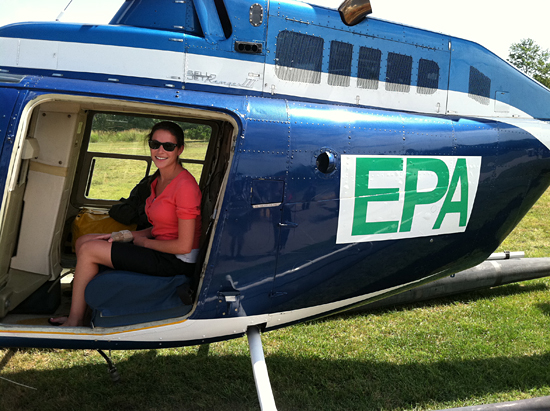
EPA Environmental Protection Specialist Dana Greenlee 11C visits the Edison, New Jersey, EPA facility.
Courtesy Dana Greenlee
Monitoring a trading and offset emissions program for polluters—making sure they “pay to pollute”—is a typical day for Dana Greenlee 11C, who began working for the Environmental Protection Agency in New York City almost immediately after graduating with a degree in environmental studies. She works in watershed management, making sure that bodies of water in the region like the Chesapeake Bay or the Peconic Estuary meet quality standards and, if not, analyzing how they can be improved. Previously, Greenlee worked at the EPA’s Washington, D.C., office on the Toxic Substances Control Act.
“The chemicals that are in our cleaners, perfumes, and body products are very alarming,” she says. Greenlee also walks most places she goes, taking public transportation to and from work and shopping at a nearby farmer’s market for local, organic, and seasonal foods. And, she says, a tiny apartment equals a tiny carbon footprint: “Living in such a small space makes it easy to make sure all chargers are unplugged, the air conditioner or heat is off, and lights are off before I leave.”
The Sustainability Professor
Stacey Swearingen White 89C: the academy and sustainability

The White Family
Courtesy Stacey Swearingen White
At the University of Kansas (KU), Stacey Swearingen White 89C is known as the sustainability professor. An associate professor in the Urban Planning Department and associate director of the Environmental Studies Program, White got interested in an environmental career at Emory. “I took a human and natural ecology course that made a huge impression,” she says. “As a philosophy major, I had been really interested in the philosophy of technology, and environmental studies seemed like a great way to ground my interests.”
She completed two graduate degrees in environmental studies, cofounded the KU Center for Sustainability, and received a sustainability leadership award for encouraging students to pursue careers in environmental fields and helping to develop a campus sustainability plan. She also organized what has become the city of Lawrence’s annual “Parade for the Earth” in 2001 and made it a family tradition to take part in the parade wearing hats of different species—including monkeys, penguins, crabs, frogs, bats, and most recently, sharks.
Drivers, Charge Your Engines
Daniel Pizarro 08EMBA and Scott Harrison 08EMBA: making electric vehicles viable

Daniel Pizarro 08EMBA and Scott Harrison 08EMBA contribute in different ways to the electric vehicle industry; electric cars and fleets are catching on across the country in part due to high gas prices.
Kay Hinton
Electric vehicles (EVs) and charging stations are a classic chicken-egg conundrum, says Daniel Pizarro 08EMBA, a regional sales director of industrial products for SQM, a Chilean company that is the world’s leading producer of lithium.
“People would buy more electric vehicles if there were more charging stations, and there would be more charging stations if more people drove electric vehicles,” says Pizarro, who himself drives a Chevy Volt company car to promote the idea of EVs (whose batteries run on lithium).
As a global marketing operations leader for GE Energy’s Industrial Solutions business, Scott Harrison 08EMBA is eager to see this leap occur.
“GE makes charging stations for electric vehicles and recently held an EV experience tour to allow people to test- drive EVs and to learn more about the new technology,” says Harrison, who met Pizarro in Emory’s Evening MBA Program.
Pizarro says his Volt is a case in point: he has driven eight hundred miles in it since January on 2.7 gallons of gas (which kicks in to charge the battery if it gets low). He plugs the car in at his Vinings office, and can drive thirty-six miles on a single charge. “Electric vehicles mean less dependence on foreign oil,” Pizarro says. “From a strategic standpoint, that just makes sense.”
SQM is environmentally minded throughout the process of mining lithium, a chemical component used to produce batteries that power most devices like smartphones and iPods. “We concentrate lithium from the Atacama desert using solar energy,” he says.
Harrison, who works in GE Energy’s Marietta headquarters, says EVs are selling well on the West Coast, and GE customers around the country are demanding more environmentally sound products. Electric vehicle home chargers are now widely available, and it is expected that there will be six hundred thousand EVs on the road by 2015, Harrison says. Pizarro is glad to be driving one already: “My electric bill only went up by $15 a month, while I was spending about $90 to $100 in gas a month.”
Energy Consult
Asa Posner 06OX 08C: sustainability consultant
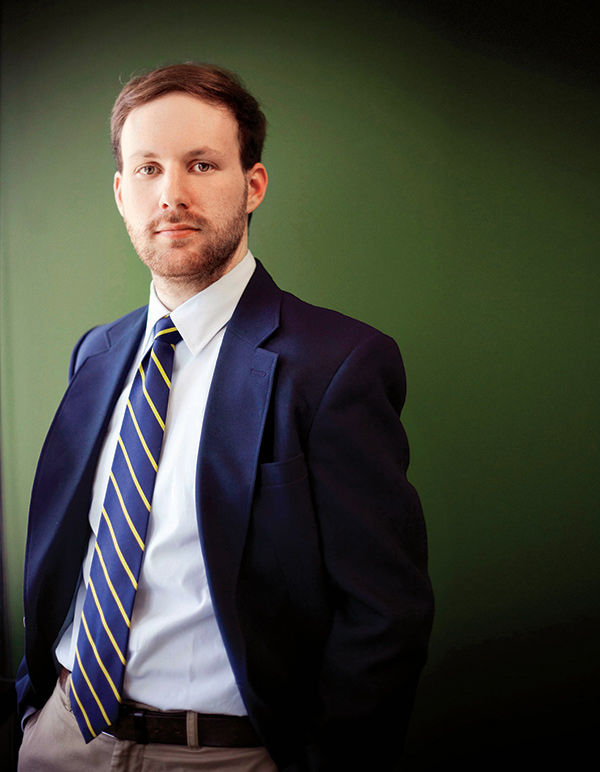
Asa Posner 06Ox 08C
Bryan Meltz
Walking through the Decatur offices of Energy Ace sustainability consulting firm with Asa Posner 06OX 08C is like taking a mini-workshop in green workspaces.
“These lights are controlled by an occupancy sensor, which turns them off when the room is empty,” he says. “All our appliances are Energy Star, and the countertops are recycled glass that look like granite. This flooring is actually recycled tires.”
Posner, who became an environmental studies major after taking a geology course from Professor Stephen Henderson at Oxford, accepted a position at Energy Ace just after graduation. He is a specialist in LEED consulting and energy efficiency and has worked on more than 120 LEED projects. “I had no background in construction, so it was a steep learning curve,” he says. “But now I can walk into meetings with architects and engineers and speak their language.” His latest project? LEED facilitator for Oxford College’s library and academic commons, a renovation and addition to the forty-year-old Hoke O’Kelley Library at his alma mater. “I was there as a student not so long ago, so it really helped out the project team that I already knew the space,” he says. “It’s kind of a unique way to give back as an alumnus.”
One Woman’s Trash, Another’s Treasure
Corey McAuliffe 11MPH: Trash for Peace innovator and collaborator
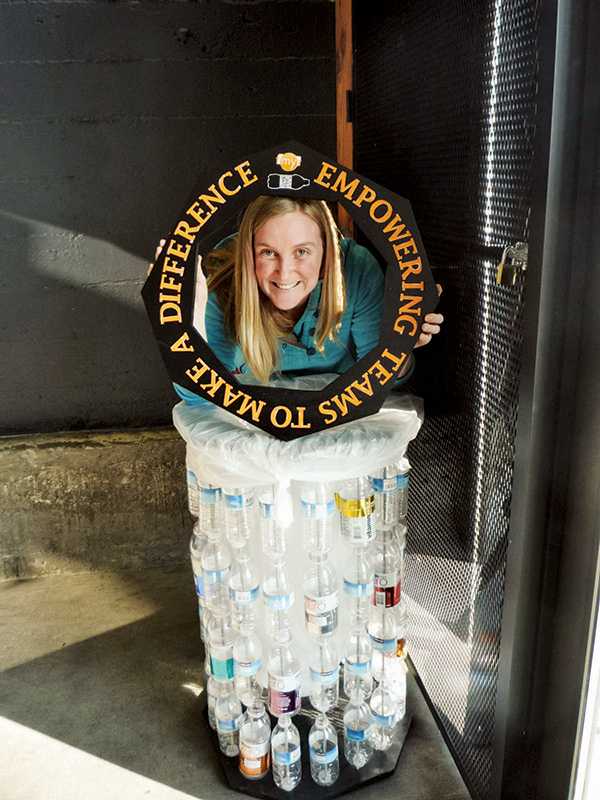
Corey McAuliffe
Courtesy Corey McAuliffe
Just after graduating from the Rollins School of Public Health, Corey McAuliffe 11MPH moved back to her hometown of Portland, Oregon, and began working with her friend Laura Kutner, who founded Trash for Peace.
“Trash for Peace works with community groups, organizations, businesses, and schools to build recycle and trash bins out of plastic bottles and other reused materials,” McAuliffe says. “The purpose is to draw attention to the amount of trash we produce through functional art, which allows us to begin an open dialogue. We also work globally, with one of our main projects being a school made out of eight thousand old plastic bottles in Guatemala, which took form as Laura’s Peace Corps service project.” To learn more about sustainability, McAuliffe took a master recycler class. Her main area of interest, since studying nutrition through the global health department at Rollins, is connecting how “our diets affect green living.”
A Not-So-Secret Garden
Chris Steinocher 86BBA: community urban gardens project
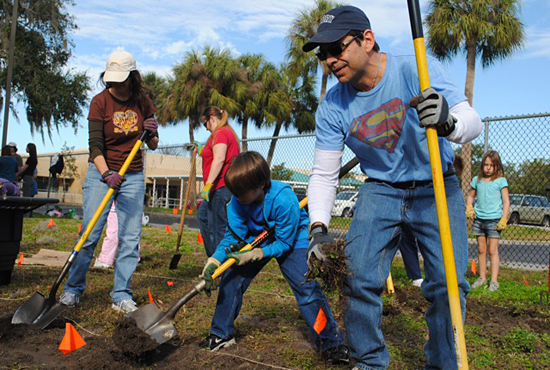
Chris Steinocher 86BBA (above, in Emory hat) and his family help prepare a plot for a community garden in St. Petersburg, Florida.
The Gabber Newspaper
Preparing soil to plant seeds is nurturing on a lot of levels, says Chris Steinocher 86 BBA, president and CEO of the St. Petersburg Chamber of Commerce, who spent a recent Saturday clearing a community garden with his family and others at a local elementary school. “The gardens remind us all of the agrarian values that most of us grew up with—get up early, work hard, be patient, embrace the earth,” he says. The St. Pete chamber is supporting a burgeoning urban agriculture movement in the city, with the intent of growing a sustainable, organic produce supply that improves the diet and health of residents.
The Sustainable Urban Farming Working Group has grown to about fifty members, and has recently been awarded a grant to hire a part-time coordinator with an office at the chamber.
“It’s an economic development play, too,” Steinocher says. “Creating jobs is all about attracting talent to your community.” Who wouldn’t want to move to a community bursting with collard greens and plum tomatoes?
Indoor-Outdoor Living
Heather Buzzard 09Ox 11C: green writer, artist, musician
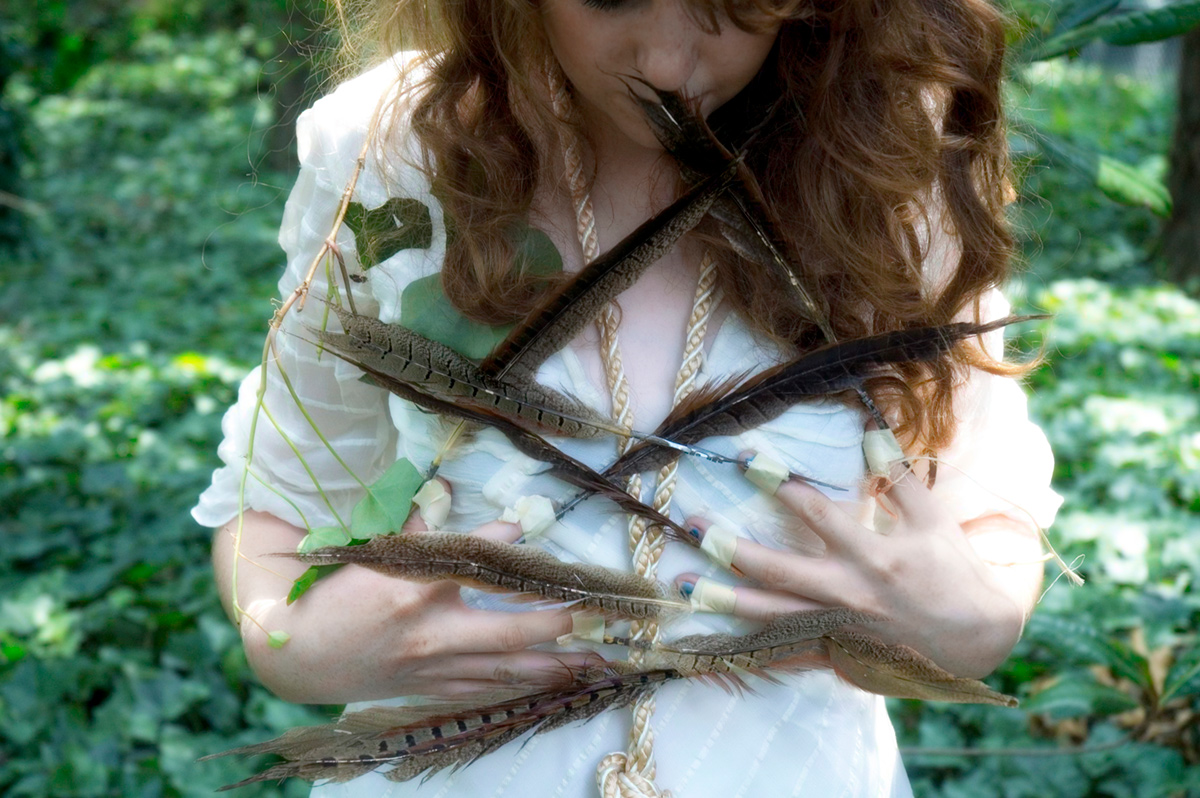
Artist and musician Heather Buzzard 09OX 11C says she likes to "hack away at the barriers between the indoors and outdoors."
Courtesy Heather Buzzard
For her internship at TreeHouseHold magazine, Heather Buzzard 09Ox 11C has written how-to pieces on making seed paper, cooking with acorns, and making moss spray paint—all of which might come in handy during her upcoming stint as artist in residence at Hostel in the Forest, a spiritual sustainability and environmental education retreat center in Brunswick, Georgia.
Buzzard studied sociology, creative writing, religion, and environmental science in college, and is a musician in two Atlanta bands. “My Emory experience, from CORE [Conserving Oxford’s Resources and Energy] to an amazing course on religion and ecology, made me conscious of global contingencies surrounding sustainable, thriving lives and shaping that lifestyle not only for myself but for our future,” she says. “I’ve always been drawn intimately to the natural world, but prior to the class, I hadn’t focused much on sharing that with others, being mindful of sacred space, and incorporating a sense of place and roots into how I live daily.”
At the Hostel in the Forest, she will be applying her understanding of sawdust composting toilets, solar panel water heaters, vegetable oil–powered lighting, organic gardening, and living off the grid.
“I like to take specific elements of the outdoors and integrate them into our everyday lives through sustainable art, design, and food, while focusing on the beauty and magic of the natural world,” she says.
And if you’re wondering if you really can cook with acorns, try her recipe.
Acorn Molasses Cakes
- 1/2 cup acorn flour
- 1/2 cup cashews, chopped
- 1/2 cup pecans or walnuts, chopped
- 1/2 cup raisins or dates
- 1 cup cooked brown rice
- molasses (or honey) to taste
- agave to taste
- 1/2 tsp cinnamon
- 1/4 tsp nutmeg
- 1/2 tsp ginger
- a pinch brown sugar or sucanat
Mix all ingredients together in large mixing bowl. Add enough molasses/honey so that concoction clumps together nicely without falling apart. Prepare a cookie sheet with parchment paper or a thin spread of butter, and ball the mixture together into smallish round cakes. Sprinkle the tops with brown sugar or sucanat. Bake at 325 for 10–15 minutes.


